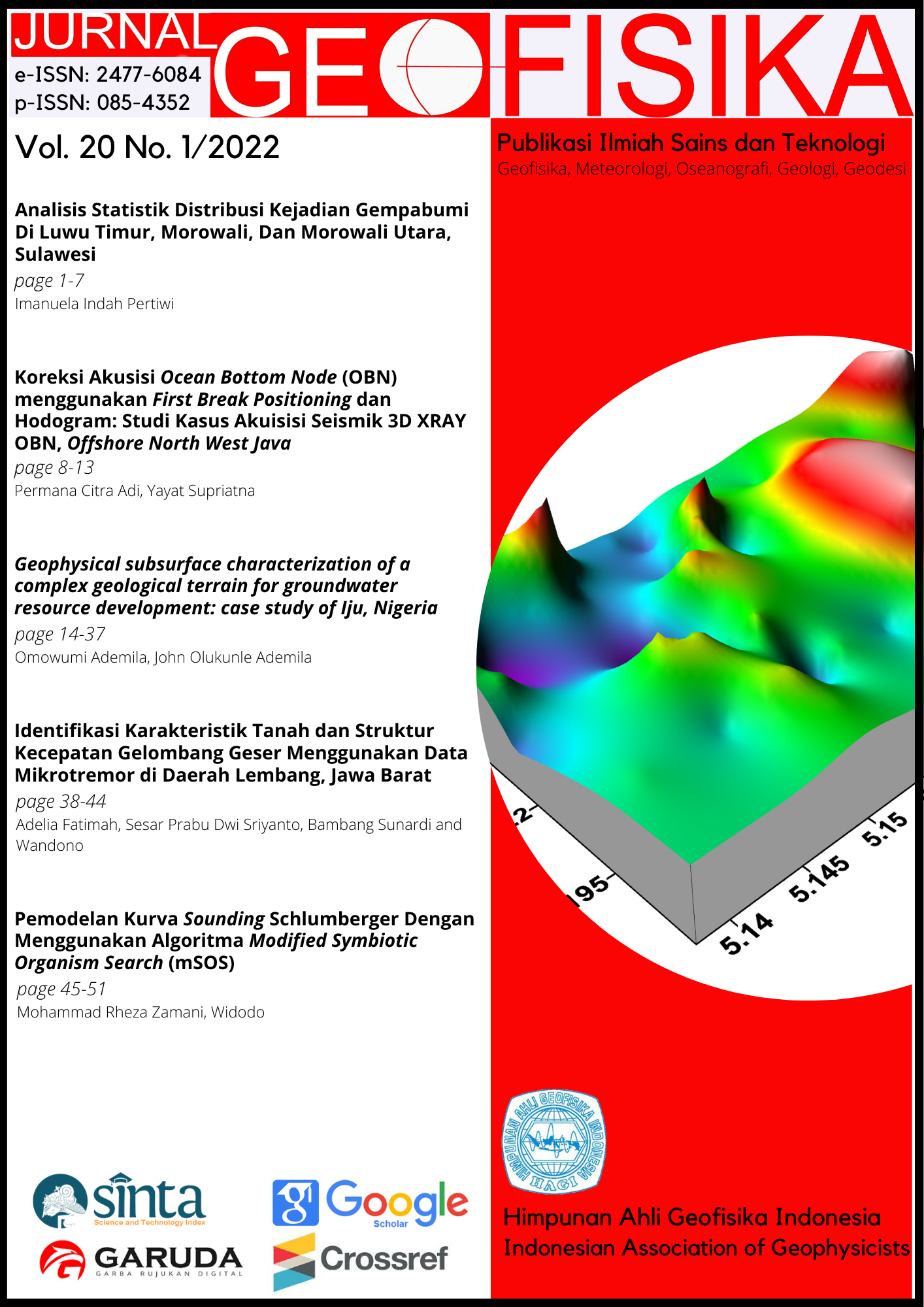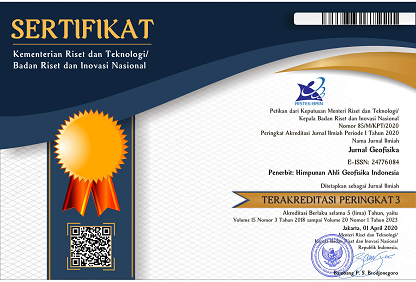Analisis Statistik Distribusi Kejadian Gempabumi Di Luwu Timur, Morowali, Dan Morowali Utara, Sulawesi
Keywords
Poisson distribution, b-value, seismicity index, probability, recurrence timeAbstract
The tectonic conditions of East Luwu, Morowali and North Morowali, which are very complex, are traversed by main and local faults, making it possible to cause large earthquakes with a strength of M≥5. This research was conducted with the aim of knowing the distribution statistics of earthquakes in East Luwu, Morowali and North Morowali. The research area was selected at 1,00oS – 3,50oS dan 120,50oE– 122,50oE. The data used is the earthquake parameter data from IRIS-DMC (Incorporated Research Institutions for Seismology Data Management Centre) earthquake catalog from 1961 to 2020. The Poisson distribution method used in the analysis of the distribution of large earthquakes, produces a graph which shows that the actual Pr% value is above the theoretical Pr% Poisson, which means that the occurrence of large earthquakes (M≥5) in the East Luwu, Morowali and North Morowali areas did not occur in the ungroups type. The spatial distribution of the b-value shows a high value in the East Luwu and Morowali areas compared to the North Morowali area. Statistically, the value of the seismicity index and the probability of an earthquake event in East Luwu, Morowali, and North Morowali decrease as the magnitude of the earthquake increases. It is inversely proportional to the rapid recurrence time in earthquakes with a magnitude M≥5 and a long recurrence time at a greater magnitude.
References
B. Gutenberg and C. F. Richter. (1944), Frequency of earthquake in California. Seismol. Soc.Am, vol. 34, pp. 185 – 188.
Bunaga, S., dkk. (2014) : Analisis Probabilistik Gempabumi di Indonesia Berdasarkan Distribusi Poisson. diakses:https://www.academia.edu/10046096
Fayanto, S., dkk. (2016) : Distribusi Poisson. Jurnal Praktikum Fisika Modern., Universitas Haluoleo.
diakses:https://www.academia.edu/30628325
Franklin A. Graybill. (1961). An Introduction to Linier Statistical Models. McGraw-Hill Book Company.
IRIS-DMC (Incorporated Research Institutions for Seismology Data Management Centre). diakses:katalog data software Zmap 7.1.
Ishimoto, M. and Iida, K. (1939). Observations sur les seismes enregistres par le microsismographe construit dernierement (1). Bull. Earthquake Res. Inst., Univ. Tokyo 17: 443-478 (in Japanese with French abstract).
Tim Pusat Gempabumi dan Tsunami. (2019). Katalog Gempabumi Signifikan dan Merusak 1821-2018. Kedeputian Bidang Geofisika-BMKG.
Lee J. Bain & Max Engelhardt (1987). Introduction to Probability and Mathematical Statistics. Wadsworth Publishing Company. Doi:10.2307/2532587.
Molchan, G.M., T.L. Kronrod, and A.K Nekrasova. (1999). Immediate foreshocks: time variation of the b-value”. Phys. Earth Planet. Inter., 111, 229-240.
Reiter, Leon. (1991). Earthquake Hazard Analysis. Columbia University Press.
Sarsito, D.A. Pemodelan Geometric dan Kinematik Kawasan Sulawesi dan Kalimantan Bagian Timur Berdasarkan Data GNSS-GPS dan Gaya Berat Global. Disertasi Doktor ITB.
Schorlemmer, D., S. Wiemer, and M. Wyss. (2004). Earthquake statistics at Parkfield I: Stationarity of b-values”. J. of Geophys. Res. 109, B12307, doi:10.1029 /2004-JB003234.
Surono, Udi Hartono (2013). Geologi Sulawesi. LIPI Press.
Tim Pusat Studi Gempa Nasional. (2017). Peta Sumber Dan Bahaya Gempa Indonesia Tahun 2017. Pusat Penelitian dan Pengembangan Perumahan dan Permukiman, Badan Penelitian dan Pengembangan, Kementerian Pekerjaan Umum dan Perumahan Rakyat.

This work is licensed under a Creative Commons Attribution 4.0 International License.
The copyright of all articles belongs to the authors. All other copyrights is held by the Journal











